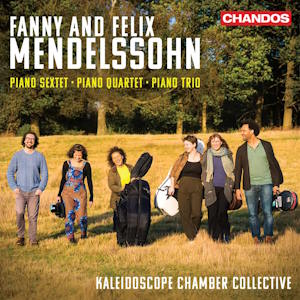
Felix Mendelssohn (1809-1847)
Sextet, Op post. 110 (1824)
Fanny Mendelssohn (1805-1847)
Trio, Op 11 (1846-7)
Piano Quartet, H-U 55 (1822)
Kaleidoscope Chamber Collective
rec. 2021, Potton Hall, Saxmundham, Suffolk, UK
Chandos CHAN20256 [68]
Chandos brings us the Mendelssohn Family Show. Come to think of it, you rarely see Fanny Mendelssohn’s music bundled with her brother Felix’s, the way you frequently get Robert and Clara Schumann (husband and wife) together, so the juxtaposition itself is a point of interest. Another shared feature: all these scores are “piano chamber music,” i.e., for piano and strings.
Felix wrote his sextet, only published posthumously, for the unusual combination of violin, two violas, cello, bass, and piano – that second viola doing the Trout Quintet one better – which biases the timbral palette towards the dark end. The score displays the refined craftsmanship of his entire output. The first movement, alertly played, delivers a nice balance among the diverse textural elementse; the players inflect more strongly on the exposition repeat, which elides smoothly into the development. A meditative, chorale-ish Adagio is followed by a driving, rolling Menuetto – more of a scherzo – in minor. The brisk finale, marked by scintillating piano runs, brings back some of the scherzo’s material, in fuller, more aggressive garb.
Surprisingly, it’s sister Fanny whose music provides the high drama. The Trio is immediately agitated, rather like Mozart’s “operatic” symphonic mode, with the piano running up and down all over the place. In the Andante espressivo, the piano launches a simple chorale, gradually joined by the strings; it moves into a brief, borderline-salonish Lied. The Finale returns to the first movement’s turbulent power.
The first movement of the Piano Quartet offers more variety, alternating forthright proclamatory gestures with a genteel “Classical” motion. The piano is prominent, both in its scintillating figurations, and in the second theme’s Chopinesque give-and-take. The agitated development resolves satisfyingly, though the movement seems to end before it’s quite ready. The central Larghetto, an almost simplistic 6/8, goes doubletime – literally, doppio movimento – in a turbulent minor. As in Felix’s Sextet, the Tempo di Menuetto is an undulating, sparkling scherzo; the ensuing playful Presto section brings more scurrying piano runs.
I don’t know the Kaleidoscope Chamber Collective, but its players are certainly fine. All the string playing is assured; the violin and cello tune their treacherous octaves well in the Trio. The pianist Tom Poster is first-class: sensitive in the lyrical passages, agile in the flashy ones. The shallow piano reproduction lets him down, however, in the Sextet, where the double-bass is boomy as well. The piano sounds more vivid in Fanny’s music.
Stephen Francis Vasta
stevedisque.wordpress.com/blog
Buying this recording via a link below generates revenue for MWI, which helps the site remain free




















